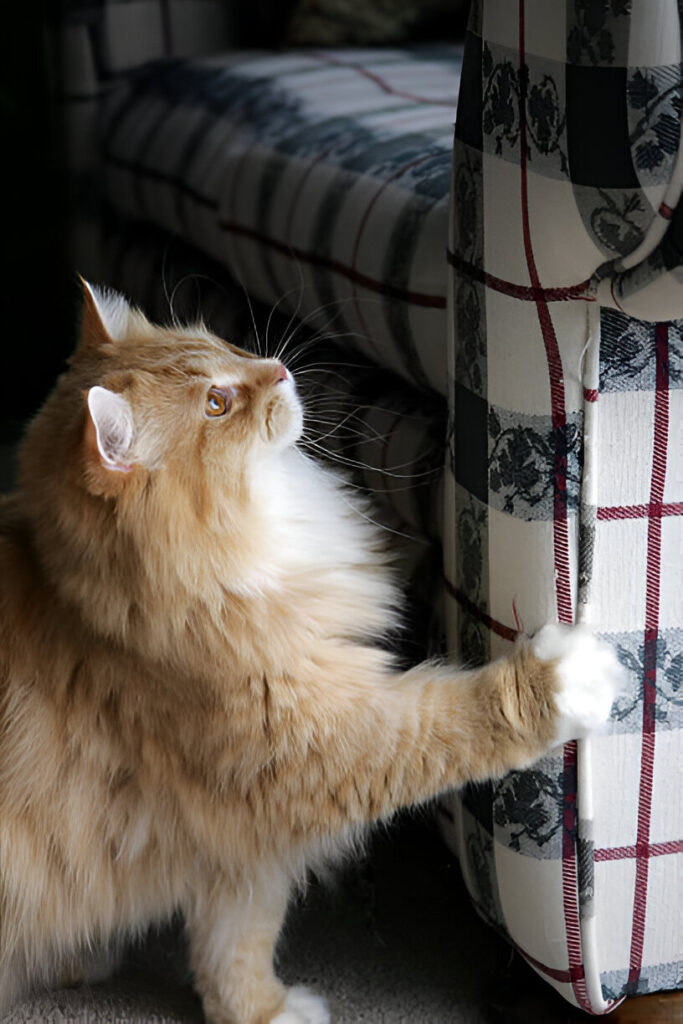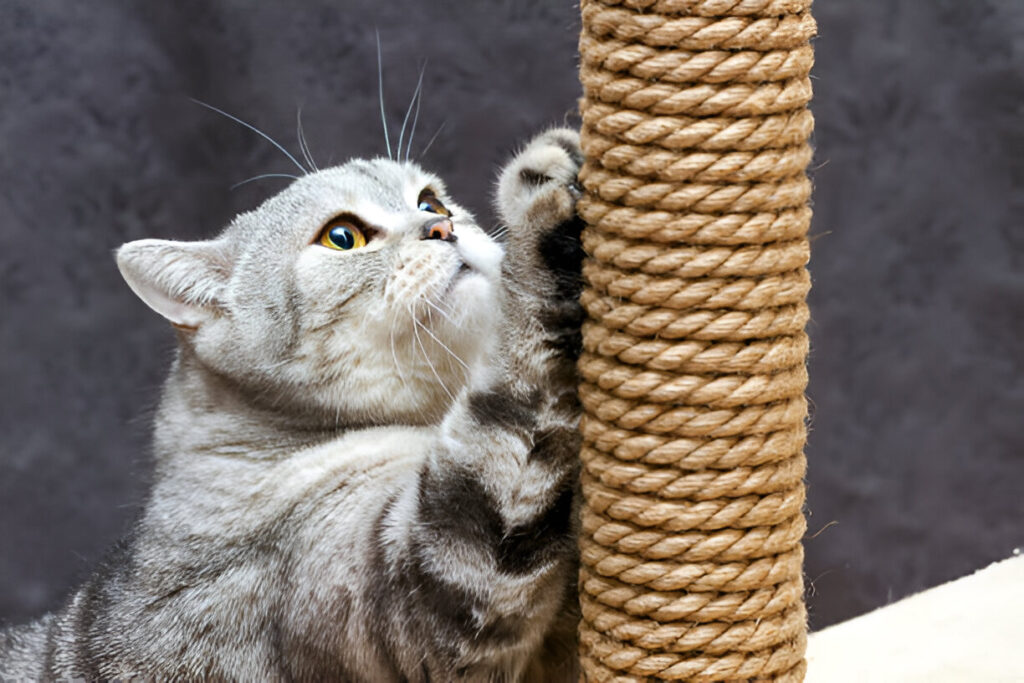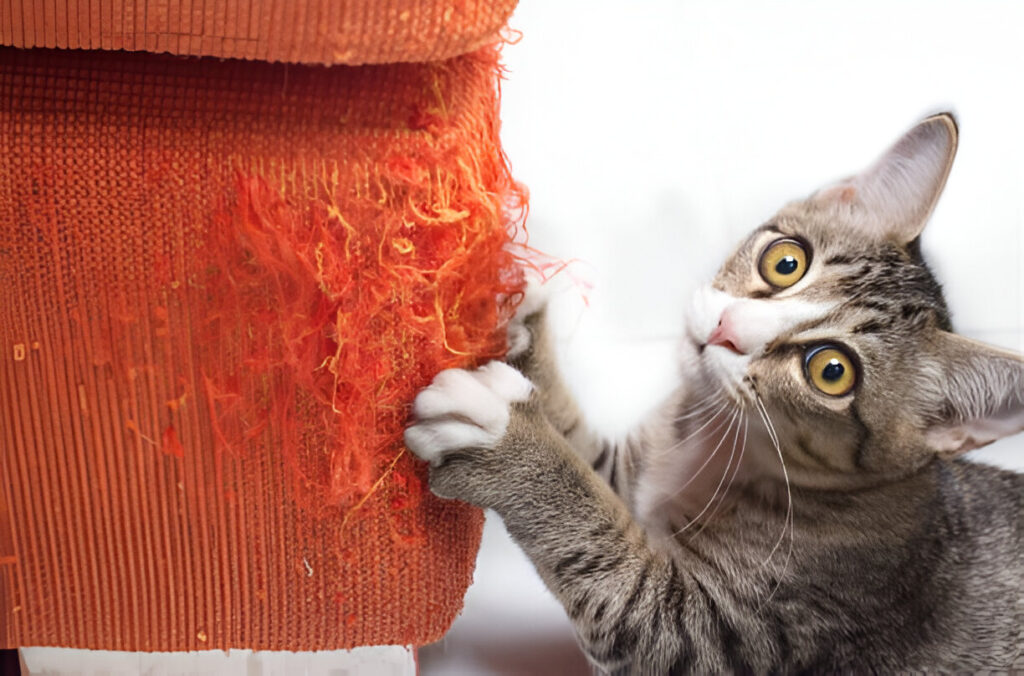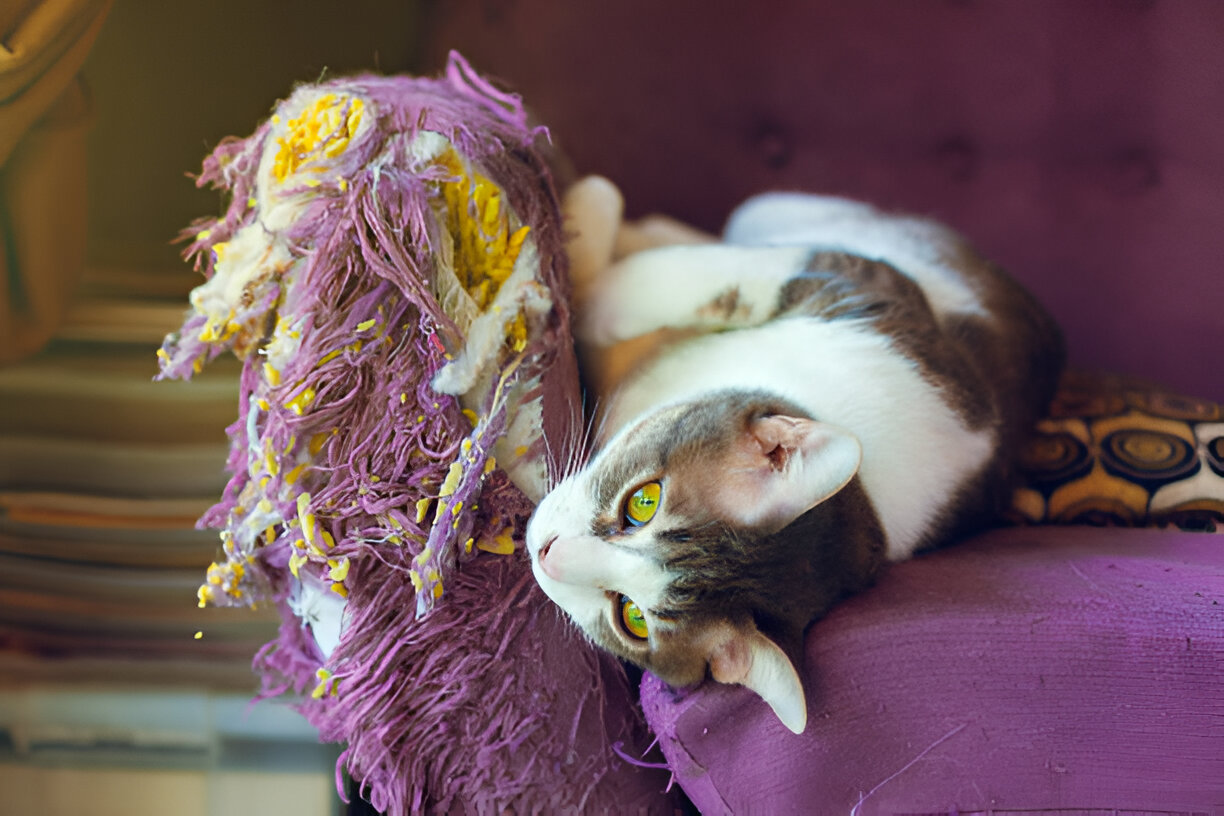Introduction
Cats are beloved companions, but their natural instinct to scratch can turn your furniture into a disaster zone. If you’re wondering how to stop cats from scratching the furniture without compromising their well-being or your home’s aesthetics, you’re in the right place. In this article, we’ll explore effective strategies to protect your belongings while keeping your feline friend happy and healthy.
Scratching is a normal behavior for cats—it helps them shed old claw layers, mark territory, and stretch their muscles. However, with some simple adjustments and training techniques, you can redirect this behavior away from your cherished couches and chairs. Let’s dive into seven proven tips to create a harmonious environment for both you and your cat.
Why Do Cats Scratch Furniture?
It is necessary to understand why cats scratch furniture before trying to solve the problem. Scratching has nothing to do with malice but is rather a deep-seated instinct serving many needs of your cat. If you are able to comprehend “why” this behavior takes place, then you can treat the root cause rather than its symptoms.

Territorial Marking: A Scent-Based Communication System
Cats are natural territorial animals; scratching is among the major means through which cats mark their territory. They possess scent glands around the pads of their paws, which leave pheromones whenever the cat scratches. These pheromones provide crucial information about ownership, safety, and territorial boundaries to other cats and sometimes even humans. Each time your cat scratches furniture, they are, in essence, signing in-a sort of way to claim, “This is mine.” This kind of behavior would be more recurrent in multi-cat households or houses where there’s some sort of perceived competition in space or available resources.
Curiously enough, this marking is not solely a privilege of cats that are allowed to leave the house. Even indoor cats mark ownership for specific areas in the home, and with such knowledge in feline psychology, you can substitute the surfaces they are supposedly “marking” with scratching posts so that your cat will leave your items intact.
Claw Maintenance: Nature’s Nail File
The other important reason cats scratch is for the maintenance of their claws. Over time, the outer layers of a cat’s claws grow and become dull. Scratching helps remove worn layers to reveal sharp, healthy claws underneath. Think of it as nature’s nail file! If your cat doesn’t have access to appropriate scratching surfaces, they’ll naturally turn to whatever is available-including your favorite armchair or wooden table legs.
Regular claw care is important in maintaining the physical well-being of a cat. Sharp claws help with climbing, hunting, and self-defense if needed. Instead of trying to eliminate scratching altogether, the idea is to redirect this natural behavior onto acceptable alternatives.
Exercise and Stretching: Keeping Fit and Flexible
Scratching also contributes to the physical health of your cat: It serves to flex the muscles, largely in the shoulders, back, and legs. When your cat stretches those front paws out and digs into something, it’s engaging in an excellent, full-body stretch that feels great and keeps them limber. This is important for indoor cats in particular, since they don’t get as much exercise as outdoor cats do.
In addition to stretching, scratching provides psychological stimulation. Cats are hunting and exploratory animals, and scratching allows them to express some of these instincts. If your cat lacks appropriate outlets for this energy, he may become bored or frustrated and scratch excessively.
Environmental Factors That Influence Scratching Behavior
A number of environmental factors can influence how often and where your cat scratches:
- Location Matters: Cats tend to scratch objects that are easily accessible and are readily visible, such as couches near windows or chairs in high-traffic areas. This visibility reinforces their territorial claims.
- Texture Preferences: Some cats love rough textures like the one on sisal rope, while others will prefer the feel of carpet or fabric against their paws. You would thus be able to find just the right scratching post for them once you begin to observe your cat.
- Stress or Anxiety: Changes at home, including rearranging furniture, adding a new pet-even loud noise-can raise your cat’s level of stress. Many cats stress themselves out by over-scratching because it comforts them and is something they have control over.
- Age and Health: While kittens scratch for curiosity and a lot of playfulness, older cats might do it because arthritis or joint pain dictates that stretching and scratching are therapeutic in nature.
How to Stop Cats From Scratching the Furniture

All that being said, let’s dive into some concrete actions you can take to curtail the behavior once and for all. It’s all about finding that perfect balance between prevention, redirection, and positive reinforcement so that you finally reach this blissful state where your furniture is intact but your cat stays happy and healthy.
Offer Appealing Alternatives
The best strategy for deterring cats from furniture scratching is the provision of some attractive alternatives. Cats are scratchers, so giving them proper surfaces to do this instinctual behavior on will shift the problem.
Invest in High-Quality Scratching Posts: Avail yourself of durable posts with coarse materials, including sisal rope, cardboard, or carpet. Sisal rope, with its coarse nature, simulates tree bark in a more attractive way. Place these posts next to areas that your cat favors for scratching-such as beside the couch or chair they’ve been attacking. If your cat has already begun using a particular furniture, placing a scratching post next to it will give him a much greater chance of making the switch.
- Offer Variety: Different cats like different things when it comes to scratching. Some are into vertical scratching, while others prefer horizontal ones. Try a few styles of scratchers to see what he likes: an upright post, a flat board, or some hanging toy to bat around. For example, kittens might adore a playful, hanging toy; older cats could prefer a firm, upright scratch post.
- Make Them Irresistible: Sprinkle some catnip on scratching posts or attach dangling strings and feathers. This will draw your cat’s interest to the post and away from your furniture.
- Case Study: Animal behaviorists conducted a study in which it was determined that providing multiple scratching options reduced unwanted scratching behavior by 70%. Cats given choices were more likely to stay with the designated surfaces than with furniture.
Deter Gently
While offering alternatives is important, sometimes you need to discourage scratching altogether. Here are some creative deterrents to help protect your furniture:
- Double-Side Tape: Place double-sided tape in areas where your cat scratches frequently. Most of them don’t like the feel of the sticky surface on their paws and thus avoid it. You can use commercially available varieties such as Sticky Paws designed for that purpose.
- Smells: Cats have sensitive noses and hate most odors like citrus, lavender, or eucalyptus. Simply place cotton wool balls soaked with these essential oils near the problems areas to discourage your cat from going there. Be careful that the smell may be overwhelming even for your cat, and perhaps irritating to her respiratory system.
- Covers for the Furniture: Place slipcovers or blankets on your furniture to somewhat protect it from your cat. These covers can protect your upholsteries besides making the area quite difficult to grasp for a cat, so they reduce the scratching.
Noise-Based Deterrents Some pet owners claimed that noise-based deterrents actually worked, and these include everything from motion-activated alarms down to cans that contain coins inside. Use such things sparingly, though-as too much would cause stress on your cat’s part.
Keep Their Claws Trimmed
Regular nail trimming is one of the easiest yet most efficient ways to reduce furniture damage. Although it will not stop scratching entirely, shorter nails mean minimal damage to your belongings.
- Start Early: Begin handling your kitten’s paws from an early age to get them used to the process. Gently press on their toes to extend their claws, rewarding them with treats or praise.
- Trim Safely: Use specialized cat nail clippers and trim only the clear tip of the claw, avoiding the pink quick (the blood vessel inside). If you’re unsure, consult a veterinarian or groomer for guidance.
- Reward Positive Behavior: After each trimming session, reward your cat with a treat or playtime. This builds positive associations with the experience, reducing resistance over time.
Pro Tip: Try soft plastic nail caps like Soft Paws. These fit onto your cat’s claws and limit the possibility of destruction without limiting their ability to scratch. These are extremely useful during the training period and for those cats that simply would not stop scratching furniture.
Encourage Positive Reinforcement
One of the most powerful tools in changing your cat’s behavior is rewarding good behavior. You’ll be reinforcing good actions when you let your cat repeat them.
- Treat Training: Any time your cat uses a scratching post or other surface on which you want it to scratch, immediately give them a treat or even praise them. In this manner, over time, they can associate the post with positive outcomes.
- Interactive play: Entice your cat into playing with interactive toys around where the scratching has to be or will be taking place. Take a wand toy or laser pointer and move that around the scratching post. Having fun and scratching go together-what a pleasant association.
Consistency is everything: Reward consistently. Sometimes old habits may revert, but steady reinforcement helps secure the new regime.
Dressed Underlying Issues
Sometimes, excessive scratching is an indication of problems that may require attention.
- Stress or Anxiety: Changes in the household, such as moving furniture, adding new pets, or loud noises, can spur stress-related behaviors. Create a calm environment by keeping routines and allowing your cat safe places to retreat to. Feliway diffusers, which release calming pheromones, can also be of help.
- Medical Issues: Discomfort or pain can lead to excessive scratching. For example, arthritis or skin conditions may make your cat scratch more than usual. In these cases, you should seek immediate consultation with a veterinarian in case of sudden behavioral changes to eliminate medical issues.
Make Your Home Feline Friendly
A stimulating environment keeps cats entertained and reduces the chances of destructive tendencies. For the most part, inappropriate scratching roots back to boredom, so enriching your cat’s world can make quite a difference.
- Window Perches: Installation near windows allows your cat a vantage point to observe birds, squirrels, and other outdoors activity for mental stimulation and satisfying their natural curiosity.
- Playthings: Rotating toys will make playtime exhilarating for them. Examples include puzzle feeders, feather wands, and battery-operated mice to provide an exciting outlet for their hunting instinct.
- Scratching Zones: Establish where scratching should occur, and keep it accessible. For example, you can put a scratching post in every room your cat accesses. You may also incorporate scratching surfaces into multi-level cat trees for an ultimate playing field.
- Vertical Space: Cats like to climb and be up high. Give your cat several shelves, wall perches, or tall cat trees to satisfy its vertical territory needs. Not only will this curb scratching, but it provides them with their security place.
Putting It All Together
How to deter cats from scratching furniture is a combination of the listed methods, tailored to the needs of your pet. Knowing why they do so, providing satisfactory alternatives, strategic use of deterrents, and making an environment friendly for them will aid in effectively rerouting behavior.
Patience and persistence are key; cats don’t change overnight. Give it time, and positive reinforcement will yield long-term results. Your furniture-and your cat-will thank you!
For further assistance with general pet care, please also read our articles on training your dog or creating an indoor safe space.
Common Mistakes to Avoid
The most common mistakes pet owners make when trying to address their cat’s scratching behavior are several. These can stand in the way of progress and may even affect the bond between you and your feline friend. Here’s a closer look at what to avoid and why:
1. Punishment: A Counterproductive Approach
One of the worst mistakes that people make is punishing their cat friends for scratching furniture. Yelling, sprinkling with water, or physical reprehension can provide an immediate result but in most cases goes awfully wrong in the times to come.
- Why It Doesn’t Work: Cats do not view punishment as humans do. Instead of associating the reprimand with the act of scratching, they may simply become afraid of you or anxious about being in the environment. This can lead to increased stress and may cause more destructive behaviors ironically enough.
- Loss of Trust: Repeated punishments break down the trust and bond you have so far been able to build up with your cat. They look to you for shelter and solace; harsh responses may create emotional distance and can lead to behavioral issues like aggression or retraction.
- Instead: Positive reinforcement and redirection. Reward your cat when they use the appropriate scratching surface, and without punishment, reposition them to avoid off-limits areas.
2. Ignoring the Problem: A Recipe for Disaster
There are those owners who would try to ignore the scratching, hoping it discourages over time. Unfortunately, this rarely works and sometimes exacerbates the issue.
- Why Ignoring Fails: Scratching is one of those very deep-seated instincts in cats. Without proper guidance or alternatives, they’ll continue targeting your furniture because it meets their needs—be it territorial marking, claw maintenance, or simply exercise. Therefore, not paying attention to the problem doesn’t eliminate the cause; it only allows such behavior to carry on without check.
- Cost of Inaction: Over time, repeated scratching can cause huge damage to your home. Other than the financial cost, there is also potential frustration and bitterness, which will affect your bond with your feline friend.
- Alternative Action: Start by providing proper scratching options and deterrents for your cat; reinforce good behavior. Early measures will ensure both your furniture and peace of mind remain intact.
3. Inconsistent Rules: Confusing Your Cat
Consistency is key when training any animal, including cats. If you’re inconsistent in enforcing boundaries or rewarding desired behavior, your cat will struggle to understand what’s expected of them.
- Why Consistency Matters: Cats are routine animals and like predictability. If one day you allow them to scratch a particular area and scold them the next, they will get confused about what is acceptable. This inconsistency makes it harder for them to learn and adapt.
- The Consequences of Mixed Signals: Mixed messages will only serve to make the scratching continue longer than necessary or become worse. Your cat may start testing the limits or even acting out because of confusion, leading to more damage and frustration.
- Instead Do This: Establish limits and stick to them. For example, if you would like your cat to scratch only on one scratching post, reward them whenever they approach it. Whenever they approach areas that are ‘off-limits’, do the very same thing in the very same manner in a cool yet firm manner.
4. Not Providing Alternatives Ample Enough
Another common mistake: not providing enough attractive alternatives for your cat. Buying just one scratching post is not enough-you need to find out what your cat likes and provide several choices.
- Why Alternatives Are Important: Cats have individual preferences for textures, shapes, and locations. Some cats prefer to scratch on a vertical post, while others use a horizontal board. By providing a range of alternatives, you will increase the likelihood of finding what your cat likes.
- The Risk of Limited Choices: Whenever the alternatives are not satisfactory to your cat, it will revert to furniture scratching, especially if the scratching surface is not conveniently available or not serving the cat’s needs.
- What to Do Instead: Try different scratching posts, mats, and boards. Place them around where your cat likes to scratch and see which they use more. Improve these surfaces with the use of catnip or attachable toys so that they’ll be impossible for them to resist.
5. Overlooking Underlying Issues
Sometimes, excessive scratching isn’t just instinct-it may indicate underlying problems such as stress, anxiety, or medical conditions.
- Why It’s Important to Investigate: A change in scratching behavior may indicate that something is wrong. For example, a cat that has begun to scratch furniture more frequently may be stressed due to the addition of a new pet, moving, or for physical reasons.
- The Risks of Ignoring Signs: The possible causes, if neglected, may deteriorate and become worse. Stress-related scratching can increase, and medical issues, if untreated, can become more serious.
- Instead: Observe changes in your cat’s behavior and environment. If you suspect stress or health concerns, consult a veterinarian or animal behaviorist for advice. By addressing the root cause, you may be able to resolve the scratching issue more effectively.
Additional Resources and Tools

If you’re interested in learning more about why cats scratch furniture or wish to discover more ways of dealing with the said behavior, several decent options are available for you. These tools can provide you with that extra support through books, online communities, and professional advice to make a home comfortable for you and your cat.
Books: Becoming Engaged in Feline Psychology
Reading about cat behavior is an excellent way to understand their motives and instincts. Following are a few highly recommended books offering practical advice and scientific explanations:
- “The Cat Behavior Answer Book” by Arden Moore: This is a complete guide that ranges from simple care to complicated behavioral problems. It has clear answers to the most frequently asked questions regarding cat scratching, with practical recommendations on how to change unwanted behavior.
- “Think Like a Cat” by Pam Johnson-Bennett: Authored by a professional cat behaviorist, the book goes into the feline mind and how to understand their needs and meet them. Sections on scratching, territory marking, and environmental enrichment are very well covered.
- “Cats for Dummies” by Kim Campbell Thornton and Debra M. Eldredge: A beginner-friendly resource that covers all aspects of cat ownership, including training techniques and solutions for common behavioral challenges like scratching.
These books will not only provide you with ways to solve certain problems but also make you more sensitive toward the nature of your cat and their specific instincts.
Online Communities: Learn From Other Cat Owners
Sometimes, the best advice comes from those who have walked in your shoes. Online communities are a treasure trove of knowledge and support, offering real-world solutions courtesy of experience owners.
- CatBehavior: This is the place for discussing all feline behaviors and finding solutions to problems. You can ask questions, share your experiences, and learn from others who have overcome similar challenges. One of the more inventive ideas shared in this community is trying to redirect scratching behaviors and create cat-friendly environments.
- Catster Forums: Catster is among the largest portals about cats, including forums on anything from grooming to behavior. The section for cat scratching there will be full of advice from fellow pet parents.
- Facebook Groups: There are a lot of Facebook groups that specifically deal with behavioral aspects or training in cats. You get to join such a group and interact with other like-minded people, share your ideas, and get tips tailored to your situation.
By participating in these forums, one doesn’t just get through an immediate problem but also creates a support system for future queries or concerns.
UPC
Professional Help: Consult Certified Animal Behaviorists
For persistent or complex issues, a certified animal behaviorist can make all the difference. These professionals specialize in understanding and modifying animal behavior, providing tailored advice to suit your cat’s unique needs.
- Find the Behaviorist: They may be certified by either the International Association of Animal Behavior Consultants (IAABC) or the Certification Council for Professional Dog Trainers (CCPDT). Many of these experts will allow consultations via video calls, so their distance is not an issue.
- What to Expect: The behaviorist will look into the cat’s environment, habits, and history for probable causes of undesirable behavior during the consultation. They then come up with a personalized plan to help solve the problem, including changing environments, training exercises, or even medical checkups where need be.
- Benefits of Professional Guidance: Working with a behaviorist ensures that you’re addressing the root cause of the problem rather than just treating symptoms. Their expertise can save time, money, and frustration while improving the quality of life for both you and your cat.
Other Useful Tools and Products
In addition to educational resources, there are several tools and products designed to help manage cat scratching:
- Scratching Posts and Mats: Buy them high-quality, made from various materials such as sisal rope, cardboard, or carpet. Sometimes, multiple types may need to be tried out to figure out which a cat likes most.
- Soft Paws Nail Caps: These are flexible vinyl covers for the claws to avoid damage, without affecting a cat’s capability of scratching. Very helpful for the training process, or where cats scratch extensively.
- Feliway Diffusers: Stress and anxiety might also be some of the major contributors to this action. Try using a Feliway diffuser, as they emit soothing pheromones that lower tension and engender relaxation.
- Sticky Paws Tape: Apply double-sided tape on the furniture surfaces. Most cats do not like the sticky feeling and therefore avoid going back to those areas.
The ASPCA provides excellent advice on cat scratching.
Conclusion
Stopping cats from scratching furniture doesn’t have to be a battle. By understanding their instincts, providing suitable alternatives, and using deterrents strategically, you can protect your home while meeting your cat’s needs. Remember, consistency and patience are key.
Take action today by implementing these tips and sharing your success stories in the comments below! For more tips on pet care, check out our other articles on training your dog or creating a safe indoor space. Together, we can ensure happy homes for both humans and their furry friends.
Yuns Legdm is a passionate advocate for pet care and the founder of this website, dedicated to providing valuable information for fellow pet lovers and veterinary professionals worldwide. With a deep love for animals, Yuns created this platform to connect passionate pet owners with expert insights from veterinarians around the globe.
This website grows with you—the passionate pet owners and veterinary experts—creating a trusted space where knowledge, experience, and love for animals come together. Whether you’re seeking advice on pet health, nutrition, or general well-being, this platform is here to support you on your journey of responsible and loving pet care.





